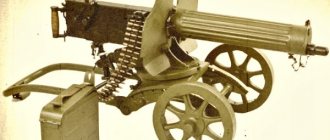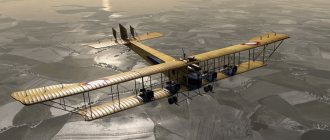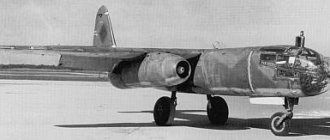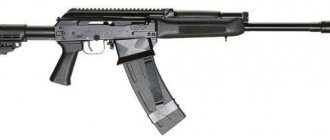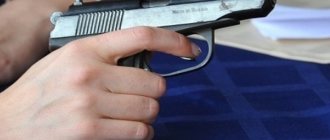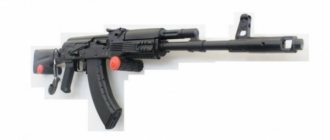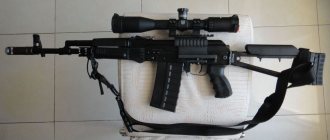The domestic carbine “Saiga MK-107” was developed by Izhevsk gunsmiths. It is designed as a civilian self-loading modification of the AK-108 assault rifle. The weapon was created and released in 1997-1998. based on the hundredth version of the famous Kalashnikov. The main difference of the model was the use of balanced automation. It was made in the image of the AL-7 (“Abakan”). The main purpose of the weapon: sporting use, game hunting, property protection.
Concept and dynamics
The main device of the Saiga MK-107 carbine includes balanced automatics. This design involves neutralizing the impulse of heavy moving elements of the weapon by equipping it with a balancer (countermass). The device moves opposite to the direction of the bolt block, minimizing its recoil and reverse impulses, which affect the stability of the carbine when firing. At the same time, dynamics and aiming are improved when working on moving targets from an awkward position.
Thanks to the introduction of a balancing structure, recoil, gun vibration and barrel instability are reduced, which is especially appropriate for high-speed firing. The Saiga MK-107 carbine with balanced automatics went into mass production in 2016. The starting modification is offered in the Remington-223 caliber.
“Made with us” and on Yandex.Zen
Izhmash will demonstrate about ten new developments at the leading international exhibition of sporting and hunting goods IWA & Outdoor Classic, which takes place from March 8 to 11, 2013 in Nuremberg (Germany). Among the new products, the Saiga-MK-107 self-loading carbine with balanced automatics will be presented for the first time.
This was reported in a press release from the Izhmash enterprise.
Self-loading carbine with balanced automatic "Saiga-MK-107"
There is every reason to believe that the Saiga-MK-107 with balanced automatics chambered for .223 Rem will become a sensation on the small arms market.
This is so far the only gun in the world that uses a balanced automatic circuit, similar to the AK-107 and AK-108.
Its essence lies in the use of an additional balancer in the design, which, when fired, dampens impulses from impacts of the bolt group, reducing recoil on the body of the weapon and the shooter, which in automatic weapons when firing in bursts makes it possible to increase the accuracy of fire by 1.5-2 times.
Small-caliber carbines for recreational shooting
Small-caliber carbine "SM-2-KO"
Small-caliber carbine "Bi-7-2-KO"
In addition, at the exhibition Izhmash will for the first time present small-caliber carbines for recreational shooting “SM-2-KO” and “Bi-7-2-KO”.
These are lightweight and easy-to-handle economy-class carbines chambered for .22LR, which differ in the barrel bore locking mechanism: for the SM-2-KO it is by turning the bolt on the handle, and for the BI-7-2-KO it is a crank - connecting rod mechanism.
Rifle for bullet shooting "Ural-5-1" with aluminum stock
Among the professional sports small arms, the plant will demonstrate the Biathlon-7-4 rifle. 11 and 12 (for left-handers) and a rifle for bullet shooting “Ural-5-1” with an aluminum stock.
For sport shooting at ranges up to 1200 meters, Izhmash will present the Record-338 manually reloading carbine chambered for the .338 LM cartridge.
Shotgun "Saiga-12" 095" with Lancaster drill and artistic engraving
Also, at the Izhmash stand you will be able to see the Saiga-12 sp. 095" with Lancaster drilling and artistic engraving made on the receiver, and elite souvenirs - models of the AK-74, SVD and PP "Vityaz-SN" in oxide.
AK-74M in airsoft version
In total, the plant’s exposition will feature 45 products, including the classic models “Bear-4”, “Los-10”, “Tiger”, “Izyubr”, “Bars-5”, “Saiga-22” and the 2012 developments - “ Saiga-9" (civilian analogues of the Vityaz-SN PP), AK-74M in the airsoft version and Saiga-12 is used. 340 for practical shooting.
Izhmash is the largest Russian manufacturer of automatic combat and sniper weapons, guided artillery shells, as well as a wide range of civilian products - hunting rifles, sporting rifles, machine tools and tools.
The company was founded in 1807. Izhmash products are supplied to 27 countries, including the USA, Great Britain, Germany, Norway, Italy, Canada, Kazakhstan and Thailand.
Rostec is a Russian corporation created in 2007 to promote the development, production and export of high-tech industrial products for civil and military purposes.
It includes 663 organizations, of which 12 holding companies are currently being formed in the military-industrial complex, 5 in civilian industries.
Rostec organizations are located in 60 constituent entities of the Russian Federation and supply products to markets in more than 70 countries. The general director of the corporation is Sergey Viktorovich Chemezov.
Net profit in 2011 amounted to 1.55 billion rubles, tax contributions to budgets of all levels reached 100 billion rubles.
More details: https://www.arms-expo.ru/053049048057124051048057050056.html
Operating principle
The weapon in question is equipped with an automatic system with a pair of pistons that serve to remove exhaust gases. They are installed one against the other, enter a common cylinder, which is located in the middle above the barrel. The rear gas piston interacts with the bolt frame through the rod. After triggering, it returns back, and the weapon is reloaded.
The front element is connected to an elongated balancer located above the gas cylinder and the bolt section. It moves along a “back and forth” trajectory. The synchronous interaction of the balancer and the frame is ensured by two gears located in a special compartment, which remains motionless during shooting. Also, these elements interact with the holes in the rod, piston and balancer.
Carbine "Saiga MK-107": device
In case of partial disassembly, the carriage with gears is disconnected from the set as a whole unit. It includes a balancer with a return spring. The last element is located in the receiver, made by stamping. The mechanism is shifted to the left from the axis of the weapon.
Closing the barrel is carried out according to the standard principle characteristic of AK assault rifles. There are rotary-type bolts with a pair of lugs. The cocking levers are made on both sides of the bolt frame and move when firing in conjunction with it. The receiver trim is equipped with a special guide element for installing additional optics.
Above the trigger box there is a safety in the form of a transverse key. In addition, the design of the Saiga MK-107 carbine includes a bolt stop and a magazine shaft, which speeds up reloading. The clip itself is in most cases taken from AR-15 or M-16 rifles. The non-folding telescopic stock is adjustable in length.
Izhmash will present the world's first carbine with balanced automatics in Nuremberg
Izhmash will demonstrate about ten new developments at the leading international exhibition of sports and hunting goods IWA & Outdoor Classic, which will be held from March 8 to 11, 2013 in Nuremberg (Germany). Among the new products, the Saiga-MK-107 self-loading carbine with balanced automatics will be presented for the first time. There is every reason to believe that the Saiga-MK-107 with balanced automatics chambered for .223 Rem will become a sensation on the small arms market. This is so far the only gun in the world that uses a balanced automatic circuit, similar to the AK-107 and AK-108.
Its essence lies in the use of an additional balancer in the design, which, when fired, dampens impulses from impacts of the bolt group, reducing recoil on the body of the weapon and the shooter, which in automatic weapons when firing in bursts makes it possible to increase the accuracy of fire by 1.5-2 times.
In addition, at the exhibition Izhmash will for the first time present small-caliber carbines for recreational shooting “SM-2-KO” and “Bi-7-2-KO”. These are lightweight and easy-to-handle economy-class carbines chambered for .22LR, which differ in the barrel bore locking mechanism: for the SM-2-KO it is by turning the bolt on the handle, and for the BI-7-2-KO it is a crank - connecting rod mechanism.
Among the professional sports small arms, the plant will demonstrate the Biathlon-7-4 rifle. 11 and 12 (for left-handers) and a rifle for bullet shooting “Ural-5-1” with an aluminum stock. For sport shooting at ranges up to 1200 meters, Izhmash will present the Record-338 manually reloading carbine chambered for the .338 LM cartridge.
Also, at the Izhmash stand you will be able to see the Saiga-12 sp. 095" with Lancaster drilling and artistic engraving made on the receiver, and elite souvenirs - models of the AK-74, SVD and PP "Vityaz-SN" in oxide.
In total, the plant’s exposition will feature 45 products, including the classic models “Bear-4”, “Los-10”, “Tiger”, “Izyubr”, “Bars-5”, “Saiga-22” and the 2012 developments - “ Saiga-9" (civilian analogues of the Vityaz-SN PP), AK-74M in the airsoft version and Saiga-12 is used. 340 for practical shooting.
Izhmash is the largest Russian manufacturer of automatic combat and sniper weapons, guided artillery shells, as well as a wide range of civilian products - hunting rifles, sporting rifles, machine tools and tools. The company was founded in 1807. Izhmash products are supplied to 27 countries, including the USA, Great Britain, Germany, Norway, Italy, Canada, Kazakhstan and Thailand.
Rostec is a Russian corporation created in 2007 to promote the development, production and export of high-tech industrial products for civil and military purposes. It includes 663 organizations, of which 12 holding companies are currently being formed in the military-industrial complex, 5 in civilian industries. Rostec organizations are located in 60 constituent entities of the Russian Federation and supply products to markets in more than 70 countries. The general director of the corporation is Sergey Viktorovich Chemezov. Net profit in 2011 amounted to 1.55 billion rubles, tax contributions to budgets of all levels reached 100 billion rubles.
Main characteristics
The domestic self-loading carbine “Saiga MK-107” has the following technical parameters:
- serial caliber - 223 Remington (5.56x45);
- total length of the weapon – 98 centimeters;
- the same figure with the butt unfolded is 1.03 meters;
- the trunk is 41.5 centimeters long;
- weight – four and a half kilograms;
- The magazine capacity is ten charges.
With all the advantages of the carbine in question, it has one significant drawback - it is a significant weight, which is 900 grams higher than the standard Saiga.
History of creation
Since the AK-107/108 models of 5.45/39 and 5.56/45 calibers were not widely used on the market for various reasons, Izhevsk gunsmiths decided to make a cunning marketing move. They developed and released a civilian modification called Saiga MK-107.
This weapon is intended to be aimed at athletes involved in practical shooting. The idea behind the idea was to create an IPS-oriented sports carbine. At the same time, it should be cheaper and more accurate than analogues. An indisputable advantage of the new weapon was the absence of barrel shaking when performing doublets, since a special mechanism was provided that corrects the moving elements of the weapon at the extreme stops.
Thanks to this solution, the shocks of the bolt frame are absorbed by the compensating impulses of the balancing compartment, which reduces tossing when firing. Compared to classic modifications, the version with balanced automation has almost twice the accuracy.
Balance on demobilization: new SR1 carbine
A little history
A long time ago, when the trees were large and the Great Patriotic War had just ended, the USSR decided to adopt an assault rifle. Since the new weapon had to replace several old systems at once, the requirements for accuracy were formulated in the style of “so that it shoots single shots no worse than the Degtyarev, and in bursts like the PPSh!” And if it was more or less possible to fulfill the first requirement, then with the second everything somehow did not work out. The designers tried, but damned physics did not want to understand the political reasons. She stubbornly believed: no matter how hard you try, a submachine gun weighing five kilos chambered for a TT cartridge will wobble less than a lighter machine gun chambered for the mod. 43.
One of the ways to achieve the results desired by the military customer was work on “balanced automation”. The principle of operation was captivating in its simplicity: to remove the influence of the recoil impulse, launch a piece of cast iron in the opposite direction, kinematically connected to the bolt frame.
Work on machines according to this scheme began in the USSR in 1965. The first “swallows” were the experimental AO-38 assault rifles (two variants) developed by Peter Tkachev at TsNIITOCHMASH. True, it was not the samples from Klimovsk that reached the finals of the competition for a new assault rifle chambered for 5.45 mm, but the development from Kovrov - the experimental SA-006 assault rifle, developed at the Kovrov Mechanical Plant by the head of the local SKB A. Konstantinov and his deputy S. Koshkarov. During testing, the SA-006 shot even better than the future AK-74. But, according to the military, it is not so much better as to justify the increase in weight of the structure, the complexity of disassembly, and additional production difficulties.
Of course, such a trifle as losing a competition could have embarrassed few people in the USSR. Fortunately, the military, having adopted the AK-74, immediately began to say that it would be nice to still have an even newer machine gun, but one that would be twice as good as the previous one.
For the next tests, in the early 80s, the balanced scheme was actively “sawing” not only in Klimovsk and Kovrov, but also at Izhmash. Initially, in Izhevsk, the balanced scheme was worked out by Yu. Alexandrov when creating the AL series machines. Subsequently, samples with balanced battery automation, the creation of which was led by Viktor Kalashnikov, became participants in tests as part of the work on Abakan. It was the battery that at the last stage became a rival to another Izhevsk model - ASM, designed by Gennady Nikonov. It was the latter that became the AN-94.
But this was still not the end of the story. Although the AN-94 showed the improvement in performance requested by the military and at the same time satisfied the requirements for reliability (how is a separate question), the very idea that there was a CABLE in a machine gun for conscript soldiers plunged the military into shock and awe. Therefore, the search for the Holy Grail, in the sense of a Kalashnikov better than the AK itself, was continued. At the recently held stage of the next competition - “Warrior” - friendship won. The AEK-i from Kovrov, with its balanced automatics, and the AK-12, which was a further development of the “regular” AK, finally came into service.
On you, wretched thing, which is of no use to us
Meanwhile, Izhevsk had in its deck not only the “last time” winner, the Nikonov assault rifle, but also its own assault rifle with balanced automatics, the AK-107. For some reason they chose not to enter it into a competition for the military, but it was decided to make it into a carbine for the civilian market. So the AK-108 (a variant of the AK-107 chambered for .223 Rem.) became the Saiga MK-107. The first rumors about it began to circulate in the weapons community back in the early 2010s. By the middle of the decade, even photos and videos of tested samples began to appear, but the date of the expected release for everyone was pushed back further and further, as if the date of the final victory of communism. However, in the end, the balanced automatics from the Kalashnikov Concern still reached buyers - however, in 2018 and under the new brand name SR1 (Sport Rifle 1).
“I have... um... not... neon inside me.”
“It was an ordinary gray St. Petersburg evening, I went for a walk in a bad mood...” Well, okay, to be fair - not an evening, but a morning, but St. Petersburg and gray, as usual. Only the mood was just good. Despite the constant road repairs and traffic jams, the authors made their way to the meeting with the next fruit of the half-forgotten word “conversion”.
For testing, we got SR1 from one of the first releases. The equipment of the carbine is no longer entirely original - since the SR1 fired out of the box, but not always. Or rather, he did shoot, but the process of cocking the bolt was, to put it mildly, far from easy and graceful.
For comparison, a 5.45 caliber Saiga carbine was also taken to the shooting range. Tuning of Kalashoids has already been discussed in our previous articles, but this is still “more of a sport than a hunt,” so let’s expand the description a little: a sports fore-end, a very effective (and very loud!) DTK, and, most importantly, a lightweight bolt frame plus a titanium piston.
So, personal impressions of shooter No. 1.
- Contrary to what was written on some forums, there is a return and it is quite noticeable.
- The center of gravity of the SR1 is greatly shifted forward. This is not definitely bad, but it requires some habit/relearning.
- When shooting at medium distances, the drift of the “tuned” Saiga when firing was felt to be noticeably less.
Impressions of shooter No. 2.
- There is a return, there is a toss. There was no “wow” effect.
- The out-of-the-box trigger requires serious fine-tuning. And not just “straighten with a file.”
- The practical value of balanced automatics in civilian weapons... a very controversial issue.
Do we need us?
To begin with, let us recall something from the same half-forgotten physics school. In the original Kalashnikov design, the bolt frame “comes” into the rear wall of the receiver at a speed of about 3 m/s. This energy reserve of moving parts allows Kalashmats to be guaranteed to grind any dirt that gets inside, to minimize the impact of the quality of cartridges, and so on. In the case of balanced automatics, we have another 3 m/s of countermass, which gives a total of 6 m/s. And this blow falls on a part that is much less massive than the receiver - the balancer gear. The manufacturer did not provide official data on the survivability of SR1 parts. According to unofficial sources, the survivability of this part is approximately 2000 shots. This is indirectly confirmed by the failures of samples of balanced circuits in military tests. In the USSR, the total survivability of individual small arms had to be at least 6,000 rounds. This is how much, according to calculations, a soldier could do within one large combined arms operation.
How critical is this parameter? Everyone gives themselves the answer to this question. For example, IPSC/MCPS shooters using CZ pistols have long been accustomed to the fact that the bolt stop is one of the consumables in their weapons. An important factor is also the question of how difficult it will be to replace the part, as well as its availability - with this the domestic manufacturer previously had a lot of problems.
As for the rest, the main thing that the average buyer should understand is that when buying an SR1 in a beautiful case, shooting skills at the level of the champions of the Concern factory team will not be attached. Moreover, there is no guarantee that an SR1 purchased for a lot of money straight out of the box will not require modifications.
Also, the future buyer should be aware of the following point: weapons with balanced automation were created in the USSR for the military. At the same time, the task was formulated as follows: to increase the accuracy of firing in BURSTS from unstable positions, while maintaining the positive qualities of the AK: the ability to work when dirty, low sensitivity to the quality of ammunition, and so on. For both the athlete and the hunter in Russia, the Fullauto fire mode is of purely cinematic interest. If we talk about reducing the toss and improving the conditions for the second shot, then even for Kalashoids a similar effect can be achieved from ordinary saezheks. Well, the AR-15 still looks more promising as a sporting platform.
On the other hand, the very fact that willing civilian shooters now have the opportunity to “try out” weapons with a balanced design themselves cannot but rejoice in our conditions.
“Let a hundred flowers bloom!” © Emperor of China Qin Shi Huangdi, followed by Mao Zedong.
The authors express special gratitude to the instructor of the Nevsky Sports Complex Artyom Glazkov for his traditional hospitality.
Russian hunting magazine, October 2022
4446
Peculiarities
Supposedly, the only possible semi-automatic mode for this civilian carbine prevents the weapon from jumping out of the hands of an inexperienced shooter. The MK-107 copy is equipped with a telescopic butt, an ergonomic pistol-type grip, and a set of Picatinny rails, which make it possible to use various additional attachments. These include:
- optical sights;
- collimators;
- handles of a different type;
- night-vision devices.
All weapon equipment is oriented to NATO standards. Even the caliber of the cartridge corresponds to the common indicator used in the northern alliance. It is obvious that the carbine will be produced primarily for export; accordingly, it is guaranteed success not only in the domestic space. This is especially true for countries where Kalashnikov weapons have enjoyed unquestioned authority for many years.
